This was published 5 years ago
The horse rescuers: saving one four-legged friend at a time
Recent reports on the sickening cruelty shown towards retired racehorses reveal just how blinkered we’ve been when it comes to bad treatment of our equine friends. It’s time to rein it in.
By Candida Baker
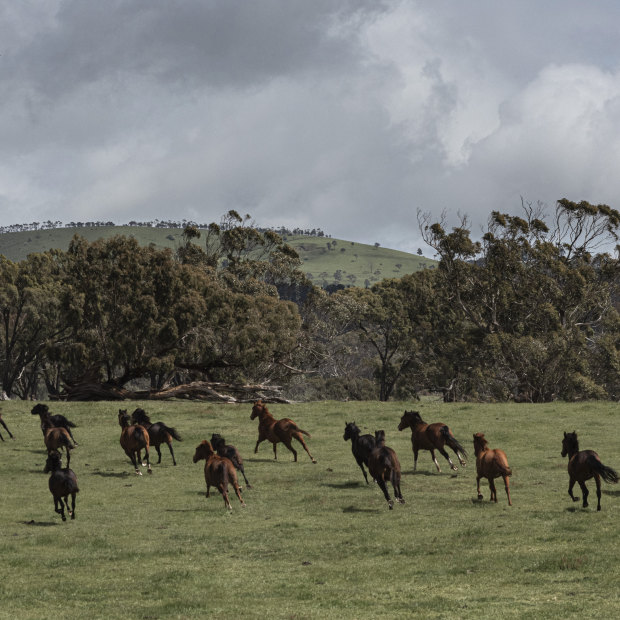
Rescue horses on the move at Anne Young’s Horse Shepherd Equine Sanctuary in Gordon, Victoria.Credit: Josh Robenstone
It’s 6pm on a freezing winter’s night, the wind is howling and the rain beating down. In the darkness, Anne Young, the president and founder of Victoria’s Horse Shepherd Equine Sanctuary, tries to coax six young rescue horses from their mud-soaked paddock onto higher ground. We bribe them along a laneway with the aid of hay, sprinkled Hansel and Gretel-style, until we finally coax the last reluctant traveller into their new home.
We shut the gate and breathe a sigh of relief. There are only the old horses near the house left to feed. Oh, and the two donkeys. And the goat that keeps the pig company. That’s before Young starts on her inside friends, the clan of rescue dogs and cats who share her life alongside the current menagerie of 102 horses, dozens of goats, a few llamas and alpacas, some geese, chickens, a peacock and a “rescue” turkey.
This weekend, the temperatures have dipped below zero on this 81-hectare property at Gordon, 95 kilometres west of Melbourne, where Young established the sanctuary in 2014 to rehabilitate and rehome horses. There are former racehorses and ex-trotters, Clydesdales and brumbies, Shetland ponies and donkeys. Any horse that’s been badly treated and needs sanctuary is welcome here, subject to space being available. Young and a handful of dedicated volunteers work to bring them back to health, get them comfortable again with humans, then adopt them out, typically to kind people with knowledge of horses who have the patience to deal with the sometimes damaged, easily spooked equine personalities.
“I got into this work in a roundabout way,” says the 58-year-old New Zealander, who works in Melbourne during the week as a senior executive with a bank. “I grew up on a farm in Ohakune, a small town on New Zealand’s North Island, and we had horses. But I’ve been in banking all my working life, so for many years I didn’t have the chance to be around them. I was transferred from New Zealand to Australia, then sent to Asia, where I lived for some years, mainly in Manila and Singapore. Preventing animal cruelty is not high on most people’s priority list there, and what I saw – dogs in cages, that kind of thing – really affected me. When I came back to Australia, I decided I wanted to do something to improve animal welfare here.”
A stocky, ginger-haired ball of energy, this tireless saver of lives is going at 100 miles an hour as we talk – preparing feed for tomorrow, directing volunteers, who include her sons, Kyle, 33, and Jamie, 31, and double-checking which of her animal charges are safe and sound on this freezing wintry night. I trail behind her, my hands deep in the pockets of the down jacket she’s lent me.
“I was incredibly naïve about how animal welfare worked,” she continues. “I’ve learnt a lot running the charity, and I’ve come to the conclusion that cruelty is the evil. Not getting a horse a dentist, not getting their feet done, not feeding them properly – all that is just as cruel as giving them a suboptimal end of life.”
Funded by adoption fees and donations, income from a new training facility and money from Young herself, Horse Shepherd works closely with RSPCA Victoria, which sends rescued horses its way. Their most notable collaboration was in 2016, when the racehorse trainer Bruce Akers was charged with animal neglect – he eventually admitted to 23 charges – after more than a dozen horses died due to lack of feed and water on his property at Bulla, near Melbourne airport. Of the other 21 horses rescued from his property, three were so malnourished they didn’t survive.
To Young, the Akers case underlined the biggest problem in the Australian horse world: the lack of national regulations around how they should be treated, and the enforcement apparatus to ensure such rules are abided by. “The horses had suffered the most terrible neglect,” she recalls of the Bulla rescues. “It should never have got to that stage in the first place. I truly believe that if all the horse-loving people really knew what it’s like out there for so many horses, the system would change. We’re talking about an animal that has partnered with humans in every aspect of their life. Do we not, at least, owe them guardianship?”
The next day, we’re up at 6am to feed her charges in one of the bigger paddocks. The horses come galloping through the rain towards us, their hooves spraying up water behind them. A pretty grey mare with a black mane and tail is particularly friendly. “She’s a Bulla mare,” Young tells me.
“She’s so sweet and young, only six years old, but she’s one that can never be re-homed. She’s quiet to handle on the ground, but if you put pressure on her to be more than just a paddock horse, she explodes, rears and bucks and is genuinely terrified. Whatever happened to her, it wasn’t good.”
The mare comes in closer for a scratch and I divert her attention from Young, who’s attempting to steer the tractor and round-bale through the gate without the horses escaping. Soon enough the tractor is off up the hill, bale in tow, the horses eagerly following her along the fence.
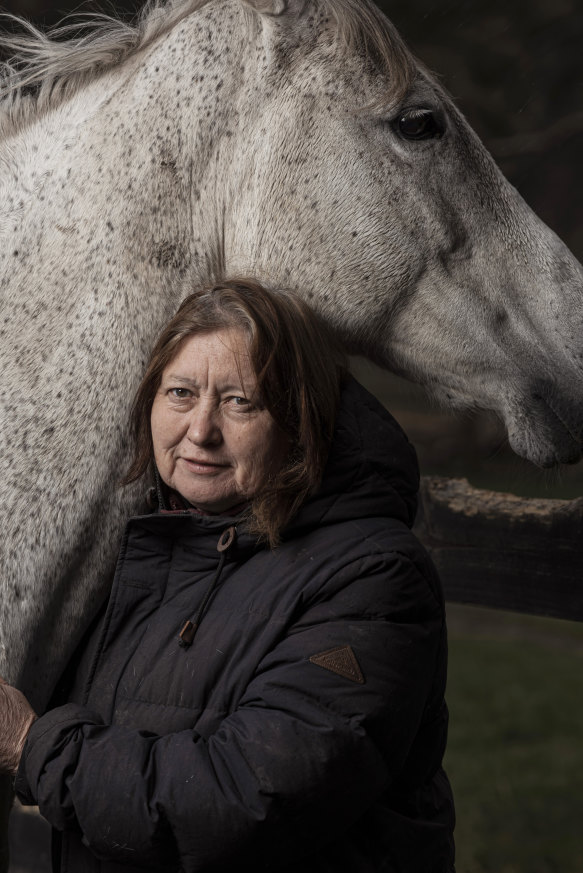
Anne Young and Ghost, a pregnant rescue mare. Credit: Josh Robenstone
As Young drives her tractor in the icy rain, I’m struck by the fact that there are people like her all around the country doing similar work: rescuing horses, running charities against the odds, picking up the pieces because Australia’s horse welfare legislation is so ineffectual. This is the backbreaking, invisible work that nobody sees. Full disclosure: I’m one of them, having been involved in horse rescue for more than 40 years, these days as president of Equus Alliance, a year-old charity founded to rescue abused horses and educate people about how to treat them better.
Late last year, I was called to help someone who’d complained about the owner of a 25-year-old mare. The owner believed the horse should be able to fend for itself, that it shouldn’t need extra feed, or its feet trimmed, or its teeth done. This mare had hooves that curled upwards like Aladdin’s slippers, with internal damage to the joints of her feet. The sharp points on her teeth had caused ulcers along the inside of her mouth, she couldn’t digest food, and her ribs were visible, as were tumours in her neck. In the owner’s absence, but with his permission, a vet determined that she should be put to sleep. Standing with her throughout the process, comforting her as best I could, I wondered – not for the first time – how on earth anyone who owned a horse could let it get into such a state.
The whole area of horse cruelty was thrust into the limelight in October, just ahead of the Melbourne and Sydney spring racing seasons, when ABC TV’s 7.30 aired the results of a two-year investigation into the sickening treatment of horses at some knackeries (which kill animals for pet meat) and abattoirs (which kill for human consumption and pet meat). The severely mistreated horses included many former racehorses, 7.30 pointing the finger at a billion-dollar industry that should do more to ensure its horses have a humane post-racing life, and a civilised end-of-life. Using undercover footage obtained by the Coalition for the Protection of Racehorses, the program raised troubling issues including overbreeding in the search for winners, and dreadful neglect and cruelty towards horses on their way to and at the abattoirs.
“The report was an eye-opener for everybody in Australia to the suffering that occurs in the slaughter trade,” says Young. “The most urgent welfare issue facing the equine industry as a whole has to be the humane slaughter of horses, from transport to the methods used. If we can address this now, then we can begin to look at issues such as the over-supply of horses.”
The program turned the public on to an issue that Debbie Barber, who runs a horse sanctuary on 32 hectares at Anna Bay, near Newcastle, NSW, has long hoped to see tackled. A slight, 55-year-old grey-haired woman who describes herself as “looking permanently tired – because I am”, Barber has been working in animal welfare for more than 30 years, currently via her Hunter Horse Haven Rehabilitation & Sanctuary. She felt a certain sense of déjà vu watching the 7.30 program, recalling a 2012 video she’d seen online in which undercover investigators, also from the Coalition for the Protection of Racehorses, went to Victoria’s Laverton knackery, only 17 kilometres from Melbourne, and secretly filmed the brutal end of a thoroughbred mare, Nature’s Child.
“I was disgusted,” says Barber, of the video. “The mare was shot in the head with a .22 but not killed outright, and processed while she was still alive, contravening all humane animal welfare standards. She was dragged by a tractor onto the slaughter-room floor, where a worker proceeded to slit her throat and cut off her tail, all before she was dead. Horses are highly sensitive, intelligent and emotional creatures. That they should face such an end was unthinkable to me.”
As a result of that 2012 video, Barber founded the Australian Equine Unification Scheme, a collective determined to work for better horse welfare legislation.
“This year’s 7.30 report highlighted the terrible truth that conditions have not improved,” she says, “and unfortunately for the RSPCA, the police and other enforcement agencies, material obtained undercover is not admissible as evidence.”Barber tells the story of a recent weekend at her sanctuary, in which a pregnant mini-pony, rescued months prior, went into labour. It soon became obvious that the stallion who impregnated her had been too big. The foal had to be dragged out of the pony, only to die. The mare spent several days in hospital. “That is the result of zero breeding regulations,” she remarks bitterly.
For those like Barber and Young, who have been fighting for decades to improve horse welfare in Australia, the depressing reality begins with the fact that there is no national registry of horses.
Some specific breeds are kept track of through registration programs attached to their peak associations – racehorses and trotters, for example – but many of these also fall through the cracks, thanks to everything from backyard breeding to the peak bodies losing track of the horses once their sporting careers are over. Assessing the total number of horses nationwide is notoriously difficult, with estimates ranging from less than a million to more than two million.
There are no national, verified figures on how many horses are killed at knackeries and abattoirs, either, although the Australian Equine Unification Scheme suggests that as many as 40,000 are slaughtered annually for either pet food here, or for human consumption in Europe and Japan.
What Young, Barber and others working in the field want, as a starting point, is a national traceability register, and a senate inquiry into its feasibility is underway. Being able to track a horse from birth to death is considered a good, albeit not foolproof, way of encouraging all custodians over its lifetime to treat it properly.
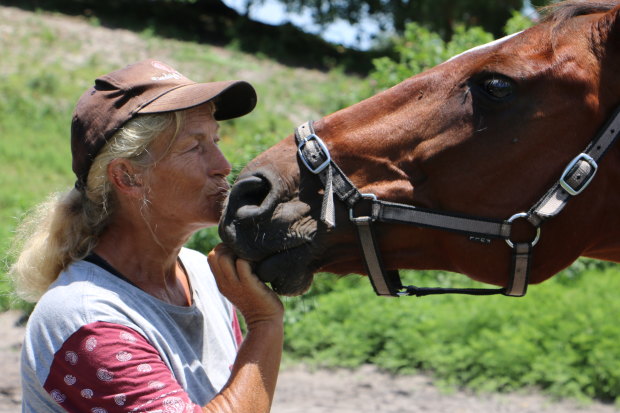
Debbie Barber, who runs a horse sanctuary near Newcastle, NSW.Credit: Charlie Elias
A few years ago, I visited the horse sales at Gympie, north-west of Brisbane. It was a hot, humid summer’s day, and standing in the relentless sun, with no shade or water, were all kinds of horses, including foals, stock horses, quarter horses, a giant black Percheron with dreadlocks down to his knees, and old, discarded family ponies. There were also young thoroughbreds, some still gleaming from their last race. These were the “dogger” pens, so called because this is where the “doggers” or middlemen come to buy horses to sell to the knackeries and abattoirs, often for less than the price of a fashionable pair of shoes. The painted numbers on their rumps and their less-than-perfect condition distinguished them from the horses in the sale ring, the pretty ones that, with luck, would go to good homes, for good money, to a future they deserved.
I tell Debbie Barber about my recollections of Gympie. She isn’t surprised. “The point is there is no federal authority that actually enforces livestock transport regulations during transport, including transport to and from sales. Sometimes a state-based authority might enforce the fact that livestock are supposed to be offered feed and water, but they have no way of knowing what’s happened in a previous state, for example. The fact is that horses are often left hungry and thirsty.”
Kelly Wall is animal welfare manager at Animal Health Australia, which helps develop animal welfare standards and guidelines. She explains that until 2005, the welfare of all livestock in Australia was governed by voluntary codes of practice. “Since 2005, we’ve developed Australian welfare standards and guidelines for cattle, sheep and poultry, but not yet for horses,” she says. “The previous Australian Animal Welfare Strategy developed standards and guidelines for horses to an early stage, but due to lack of funding, they were put on hold.” Wall directs me to the animal welfare standards website, where I find a recent Horse Wellbeing Toolkit. I click on the tab: “There has been no progress on the early stage draft standards and guidelines for horses since 2011.”
What should such regulations cover? “Everything from food and water to risk management, disease, facilities and equipment handling,” Wall says, pointing out that the transport of horses is covered by the federal government’s land transport standards, which “are there to ensure the care and management of livestock that are transported”.
Wall says the transport regulations are enforced, to Debbie Barber’s disbelief. “They talk about the regulations, but I’ve never heard of anybody pulling over a horse truck to see if they’re loaded correctly,” she says. “If they did, they’d be likely to see blood all over the floor, injured horses, and even, according to reports we’ve received, dead horses.”
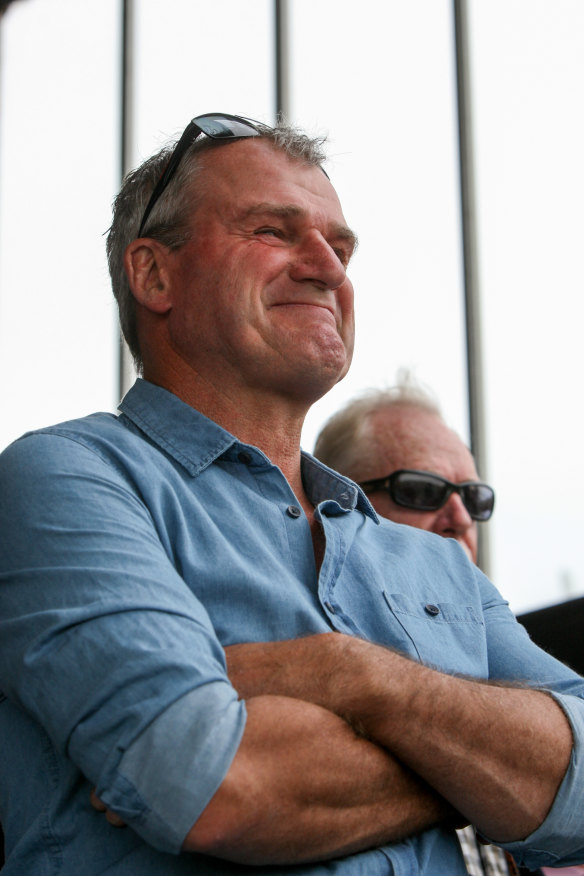
Trainer Darren Weir, disqualified for four years for owning a device which gives a horse an electric shock.Credit: Rob Gunstone
From thinking about horses in the dogger pens at Gympie, my mind turns to the high-profile thoroughbred trainer Darren Weir, who was disqualified from racing for four years in February for possessing “jiggers”, a device which gives a small electric shock to the neck of a horse when applied by a jockey, designed to improve its performance. In an unrelated matter, Weir has been accused of multiple counts of torturing, abusing, overworking and terrifying horses, and causing unreasonable pain or suffering. He and two of his employees were charged by Victoria Police, with the case due to return to court in February next year. Weir has since sold his stables.
I ask Victorian-based equine specialist Dr Glenn Robertson-Smith, one of Australia’s most respected veterinary surgeons, about jiggers. “To have these battery-operated pieces of equipment is absolutely unforgivable and those who use them should face life bans from racing and criminal animal cruelty charges with possible jail time,” he says, likening them to instruments of medieval torture. “They’re used sometimes three days before a race by running the batteries up and down the horse’s neck, followed by a loud roar from the jockey. And that practice is repeated in an actual race, with the butt of the whip substituted for the battery. If horses are terrified, they will run until they drop. It’s cruel, and it’s time for Racing Victoria to be proactive, not reactive.”
At Racing Victoria, Jamie Stier, the executive general manager of integrity services, points to the fact that his organisation announced an Equine Welfare Strategic Plan in July, and in October committed $25 million to equine welfare with an acceleration of the strategic plan. One of its key aims is to facilitate the journey of off-the-track racehorses into their next careers, and into appropriately knowledgeable homes. Racing NSW has its own program designed to ensure racehorses don’t end up as pet meat, funded by a 1 per cent levy on prize money at NSW race meetings. (Despite these programs, many still do, as the 7.30 investigation highlighted.)
That’s all very well, but how did Weir, one of Victoria’s highest-profile trainers, slip under the radar with the jiggers? “While it was a sad day for racing it is important to remember that it was Racing Victoria who initiated the investigation, before referring the matter to Victoria Police’s Sporting Integrity Intelligence Unit in 2018,” Stier responds. “Anything which impacts on integrity or horse welfare is very much in the forefront of Racing Victoria’s mind. We conduct routine stable visits of trainers and from what we see out and about, the vast majority of the trainers care enormously about the horses in their care.”
That level of care is why the 7.30 revelations came as a shock to so many working in the industry. Arthur Inglis, deputy chairman of the thoroughbred auctioneering company Inglis, was deeply disturbed by evidence of a lack of humane processing, including the use of a captive bolt-stunning method on horses in Australia. Also called “percussion stunning”, it produces a physical shock to the brain which, if done correctly, causes irreversible damage. Once the horse is unconscious, its throat is slit and it bleeds to death. The problem is that the bolt was designed for cattle, not horses, and is often not administered properly.
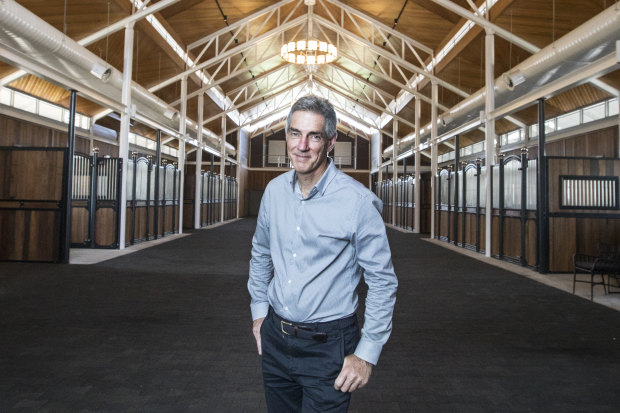
“We’re advocating tracking and all-of-life care,” says Inglis auctioneering deputy chairman Arthur Inglis. “How we do it, that’s the issue.”Credit: Jessica Hromas
“Even if you talk about this at its most basic level,” Inglis says, “which is that, sadly, some horses might have to end up being processed – thoroughbreds or non-thoroughbreds – why is it that Australia is apparently using a bolt designed for cattle?
“I think all horse lovers would like to have a better understanding of these issues. Ideally, we would press the pause button on processing for a moment and think things through. There are steps the industry and government could be taking to improve horse welfare, and we should be doing it as quickly as possible. At Inglis, we’re advocating tracking and all-of-life care, but how we do it, that’s the issue at the moment.”
Greg Nichols, chairman of peak industry body Racing Australia, agrees that a national traceability register would be a good starting point. “Racing Australia has been very active in promoting the importance of widening the traceability of horses and where they are at, at each stage,” says Nichols. “We believe it should be for all horses. There needs to be reliable data and that sort of data will clearly have equine welfare implications.”
It would help, too, if the lax federal, state and territory laws that relate to horse welfare were standardised. At present, they differ vastly, as does the ability to enforce them. “As the governing body, we can only work with the powers that are conferred on us by our constituents,” says Nichols. “The operational component will remain the domain of each state and principal racing authority. However, that doesn’t mean we don’t have a major role to play in welfare.
“It’s a coalition of the willing – there are no deniers, no naysayers. I don’t think there’s one solution that’s going to accommodate all the welfare issues raised. It’s going to be an aggregate, but what has become very clear is that Racing Australia, and every state racing authority, needs to take responsibility for the pre-racing, during-racing and post-racing career of thoroughbreds in this country.”
Tom Reilly, CEO of the Thoroughbred Breeders Association, is clear about the change in thinking that’s required. “If you look at a thoroughbred’s life, it’s bred by a breeder, sold at 18 months to a trainer, let’s say it races for three years in the city, and then perhaps goes to be a country racehorse for a few years, and let’s say that each one of those people have looked after the horse brilliantly,” he says. “But now he’s getting on and needs to retire – he goes to someone who says they’ll look after him, they don’t, and he ends up at the sales.
“Whose responsibility is it that the horse doesn’t meet a bad end? In a legal sense it’s not the breeder, the first owner or trainer, or even the second owner and trainer. What racing is grappling with is not having a legal responsibility but having a moral responsibility. It’s obvious. We can’t have people enjoying racing at the same time as what we saw on the ABC is going on. Everyone in the industry needs to examine their contribution, and part of that is to consider how many horses we’re producing.”
Scott Meyers, the chief inspector of the RSPCA in NSW, has been a horse person all his life. One of five children, he grew up on properties in western NSW, and has been with the RSPCA for 14 years. “I’ve seen cruelty to horses I can’t even speak about years later,” Meyers tells me. Hoarders slipping through the cracks are a common problem. “Animal hoarding is often linked with other mental health issues. People collect them as if they’re toys and then neglect them. It’s probably one of the worst forms of individual cruelty.”
Perhaps horses should be classified as companion animals, which would give them far greater legal protection than the no man’s land they inhabit at the moment. Companion animals, such as dogs and cats, have much tougher anti-cruelty regulations. Meyers’ response is diplomatic: “If you look at the horse industry in Australia and take every kind of discipline into account, the vast majority of people treat their horses well, and regard them as companion animals. Unfortunately there’s a small percentage that don’t.”
Like most in the industry, Meyers favours a national registration scheme. “When the equine influenza epidemic hit us, the good thing about it was the micro-chipping and knowing where every horse within a zone was actually located,” he says. “Unfortunately it was a missed opportunity, because once it was over the data was simply lost, so there are micro-chipped horses all over the country, but nobody actually knows where they are.”
Arthur Inglis finds the current non-traceability of horses frustrating. “We can chart a cow’s life from birth to death,” he says. “Ideally we would set up a system where we can keep track of horses. It will take a lot of skill and will, but that’s the standard we want to aim for.”
Thoroughbreds have perhaps a better chance of quickly improved conditions, with compulsory micro-chipping and studbook registration already in existence, and the industry grappling with the welfare issue in the full glare of the media spotlight. But many people believe the foundation upon which horse protection is built in Australia is flawed. One such person is Melbourne-based Justine Curatolo, who has cared for horses in one way or another for most of her life. As a social worker, she advocates for humans; in her private life, she champions animals and the environment. She is the report coordinator for the Australian Unification Equine Scheme, and president of the Heritage Brumby Advocates Australia Inc.
“Politically in Australia, the structure is so poor that it is very hard to get a systematic approach to the welfare of horses in this country,” she says. “No agency will enforce the welfare of the horse around Australia from top to bottom. We know of cases where valuable horses – even children’s ponies – have ended up at the saleyards, and have been bought for slaughter. Someone presents a horse for sale, and through our experience, and through reports received, the auctioneer accepts the horse without question, it sells or doesn’t sell, or it goes to a meat buyer. It may have been stolen, or fraudulently acquired and it simply disappears. Currently there is legislation to prevent this type of behaviour, but without stringent enforcement these poor practices continue.”
Curatolo says regulation is better in the European Union, which, as a buyer of Australian horsemeat, might be the best way to force change here. There are currently no regulations governing horse rescue in Australia, either. “Of course there are many people running good charities,” she says, “but there are many places where horses that have supposedly been ‘rescued’ don’t find themselves in a good spot, or charities running on less than good governance.”
I’ve been sent videos and reports from around Australia of such horrific cases of cruelty to horses that a few times I wondered if I could actually write this story. Watching a video of a horse lying on the ground of a saleyard in his own blood and urine while a man beat him senseless with a piece of wood, my heart broke in pieces.
Curatolo says, “There is a lesser standard for transporting horses to death, and even that is not enforced because the belief is that they are going to be killed anyway.” Yet, despite all the problems, she insists that horse welfare in Australia could easily be improved. “It’s not hopeless. Australia has the capacity and resources, now we need good leadership and political will to drive the change.”
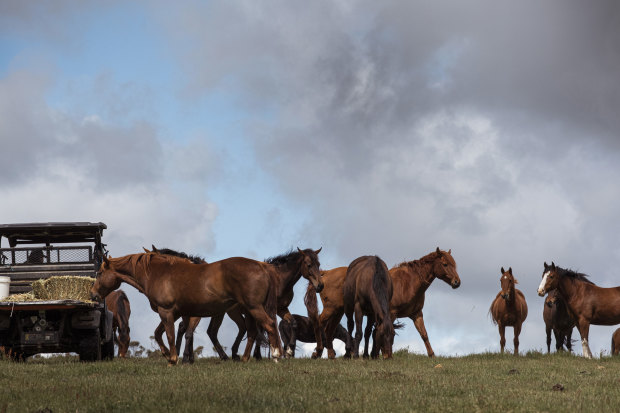
Self-feeding service from the back of a four-wheeler for the rescue horses at Anne Young’s Horse Shepherd Equine Sanctuary in Gordon, Victoria.Credit: Josh Robenstone
When I look out of my study window, I see my two thoroughbred mares. Tyra, an ex-racehorse and broodmare, an elderly matriarch of 21, rescued by a Queensland horse charity and adopted by me. And Eva, a five-year-old ex-racehorse who met an early retirement due to the worst hooves I’ve ever seen. These two are the mainstay of my current horse life, which along with continued rescue work involves equine-facilitated therapy, in which the horses help treat people with a wide variety of emotional issues.
Horse therapy is a growing field worldwide, and a great way of employing horses that, for various reasons, are not able to be ridden. Tyra and Eva live happy, useful lives and I love them dearly. I can’t imagine my world without them. Is it being too optimistic to hope for a future in which all horses are cared for properly, and a world in which humans put the safety and wellbeing of these magnificent creatures at the heart of all their dealings with them?
To read more from Good Weekend magazine, visit our page at The Sydney Morning Herald, The Age and Brisbane Times.